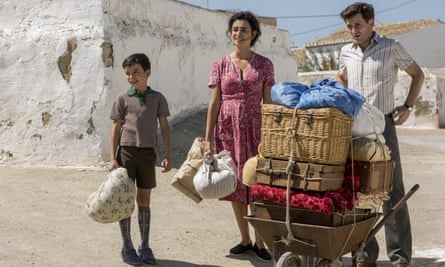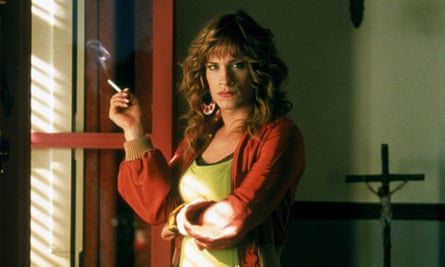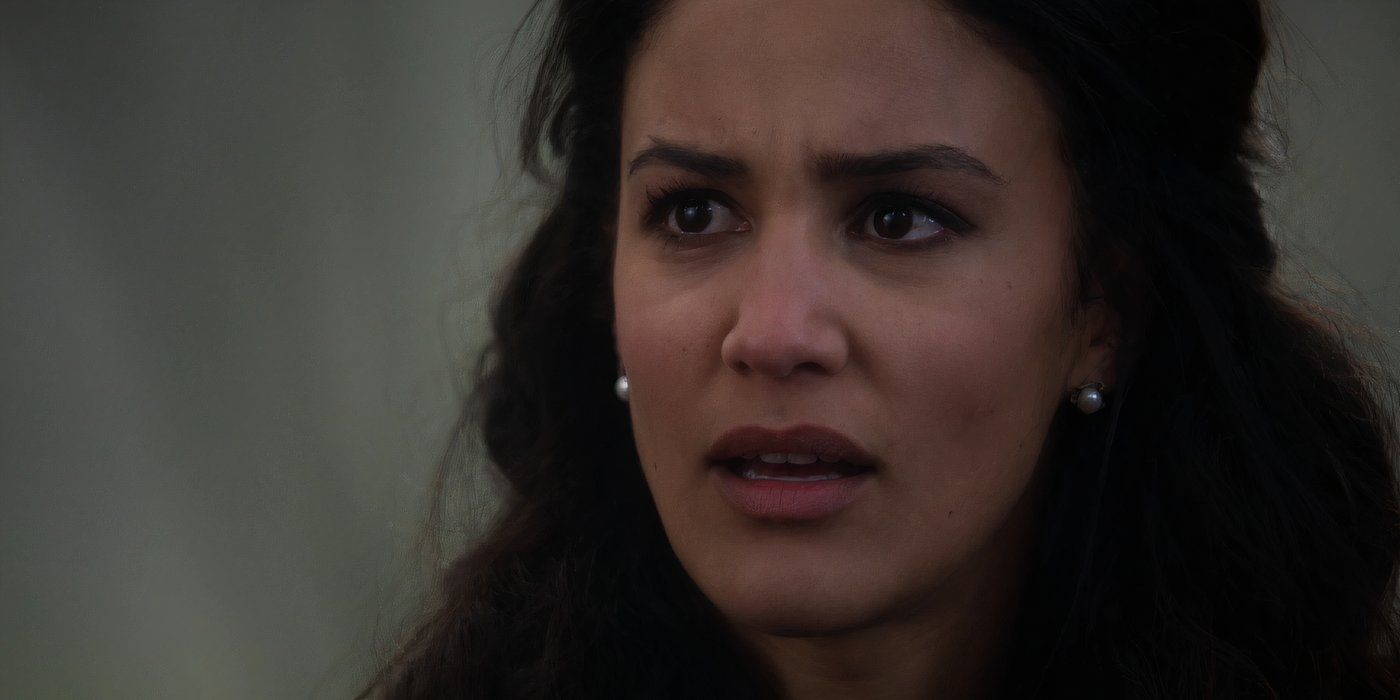One day when he was nine years old and living in a small Extremaduran town of makeshift adobe houses, steep slate streets and dusty, meagre horizons, Pedro Almodóvar caught his mother out in a lie.
The family had recently moved south from La Mancha and Francisca Caballero was making ends meet by reading and writing letters for her illiterate neighbours. As he read over his mother’s shoulder, Almodóvar realised the words on the page did not correspond to the words on her lips.
“She was improvising and saying things that weren’t in the letters,” he says. “My mum knew all the neighbours – she knew the grandmother and the granddaughter and how they got along. And so she made stuff up. For example, if she noticed that no one had asked after the grandmother, she’d say, ‘I hope Granny is very well and knows that I think about her a lot.’ That wasn’t in the letter.”
When they got home, he asked why she had made up the reference to the grandmother. His mother looked at him and replied: “Did you see how happy it made her?”
At the time, Almodóvar was most struck by the fact of the lie. But, as the years passed and he began writing stories on the Olivetti typewriter his mother gave him when he was 10, he came to understand the meaning of her actions. “I realised just what a huge lesson she’d taught me: that life needs fiction to make it bearable. We need fiction so that we can live a bit better.”
The truth his mother imparted that day lies at the heart of El último sueño, the short-story collection-cum-memoir now published in English as The Last Dream. Almodóvar, 74, has travelled an almost unfathomable distance from the house in Orellana La Vieja whose bare earth floors would turn to mud under his mother’s mop. The smart central Madrid offices of his production company, which sit near a yoga studio and a short walk from the neo-Moorish splendour of the city’s Las Ventas bullring, are lined with film posters – Tie Me Up! Tie Me Down!, High Heels, Live Flesh, All About My Mother, Volver – that describe a singular director now in the sixth decade of his career.
Just as those films have become time capsules of his life and his era, so the dozen stories that make up The Last Dream, which has been translated by Frank Wynne, are snapshots of his development as a person, a writer and a film-maker. Lacking both the patience and the inclination to write an autobiography, Almodóvar opted instead to offer the reader a brisk, eclectic and idiosyncratic tour of his memories and imagination.
There are fictional tales of misfits, outsiders, actors and the odd supernatural entity. One tells of a writer whose life is lived backwards, beginning with his burial and ending with him being placed between his mother’s legs to die; another of a wounded soul out for revenge on the priest who abused them as a child; another of a world-weary vampire seeking solace in a monastery. There is a cult film director in the throes of a crisis, a homoerotic and Bible-changing encounter between Jesus and Barabbas, a record of Almodóvar’s much-treasured friendship with the remarkable Mexican singer Chavela Vargas, and, at the book’s conclusion, a melancholic sense of the director’s retreat from the hedonism and delightful chaos of the 1970s, 80s and early 90s, as chronicled in his early films.
The stories are as inescapably Spanish as their creator: the little boy abused by the priest is given turrón (nougat); a hospital drainage bag contains “sangria-red urine”; and the director teetering on the verge of a nervous breakdown still manages to fit in a spot of present shopping at the local Vips cafe.

A mix of fiction, observation and autobiography, the collection exists largely thanks to the care and efficiency of Almodóvar’s long-serving assistant Lola García, who assiduously grabbed and filed the pieces over the decades, preserving them from house move to house move. Some were written in his late teens and early 20s, others during his first years in Madrid, and some as recently as last year.
“I decided that I wanted to involve the reader in these stories, which, in some way, describe my genesis – as a film director and as a scriptwriter,” says Almodóvar. “Through them, you can kind of see the universe in which I live, my mentality, and how I deal with certain themes.”
As the collection progresses, you can almost see the artist develop: the kitsch, riotous and transgressive early work giving way to something calmer, sadder and increasingly self-reflective. Over the course of 211 pages, the exuberant, coal-haired enfant terrible of Spanish cinema becomes the salt-and-pepper-haired auteur of the late 90s and then, finally, the thoughtful, white-haired sage who sits on the other side of the desk on a merciless Madrid summer afternoon and explains, over bottled water, why the 12 tales tell a more honest story than would a straightforward memoir.
“There’s a biographical line that runs through them, even though some of them are pure fiction,” he says. “It’s a way of looking back at something I found interesting, because I recognised myself in all those stories: even if some were written when I was 17 or 18, I’m still the same person. Yes, things change, time passes and biology changes – there’s nothing you can do about that – but I’m exactly the same person now as I was when I came to Madrid fortysomething years ago.”
The approach also suits an artist whose work is inspired by other films, his reactions to those films, what he reads in the paper and snatches of overheard conversations. Despite The Last Dream’s blend of the imaginary, the real and the recollected, “this is an autobiography in the sense that it represents different stages in my life, and it represents them in a way that’s profound and sometimes mysterious. It’s not obvious. But each page and each line is talking about me.”
Although Almodóvar is modest about his literary abilities, writing was his initial vocation and one that he has pursued from the early days of tapping away on his Olivetti “under a grapevine with a skinned rabbit hanging from a string, like one of those revolting flycatchers”, to the scripts he wrote on the sly while working for Telefónica in Madrid.
“I’ve wanted to write from the very beginning, and I thought about devoting myself to literature, but from the time I was about 18 or 19 – when I’d bought a Super 8 camera – I immediately turned all those literary ideas into images,” he says. “I also discovered that I was better at telling stories with images than with words. Very often, I’d start writing a story but it would end up as a film script.”
Cinema had long been an escape from the claustrophobic confines of his provincial upbringing. “I’d already learned from living in small communities that I was different,” he says. “People made me see that I was different. Life there horrified me. I started going to the cinema when we lived in Orellana and I continued going when we moved to a nearby village. From the moment I discovered cinema, I discovered a parallel reality that interested me far more than daily reality.”
After arriving in Madrid, he came to recognise the differences between writing a short story or novel and a film script. The latter isn’t normally something of great literary value “because the instructions you give to the actors, or to a character, or to the director of photography about the lighting, or to the wardrobe mistress, would be narrated in a novel – and narrated with style. You don’t have that here. You just say, ‘You’ve just come into the room through the door and sat down opposite me. We begin to talk.’ In a novel, that could almost become the story itself, because of the thoughts you have between the door and the chair. It could be what you’re thinking about me or what I’m thinking about you. For me, a novel is something much more complete in terms of story than a script.”
But while Almodóvar believes it’s harder to write a novel, being a great novelist is no guarantee of success as a scriptwriter. “There’s a lot of examples of that but the one I’ll give you is Cormac McCarthy, who I like a lot. You’d think – or at least I’d think – that this guy would write a good film script because he’s very good at dialogue and his novels are based on dialogue. But he wrote a script, single-handed, called The Counsellor, which was directed by Ridley Scott and which had Penélope [Cruz] and Brad Pitt in it. It was really weak and the film didn’t work. They’re two different disciplines.”
Nowhere in The Last Dream is the intersection of literature and cinema clearer than in The Visit, which Almodóvar wrote shortly after finishing his baccalaureate, and which he would film 40 years later as Bad Education. The short story, rooted in fury at the director’s painful, deeply influential religious education in his “prison-school run by the Salesians”, is about a victim of child sexual abuse who tracks down the priest responsible. But the rage he felt when he wrote The Visit – a deliberate and angry attempt “to twist and challenge what I’d been taught” – evolved over the years, and Bad Education eventually became “a noir that I combined with other things that interested me at the time”.
It is impossible to overstate the influence of that Salesian education in the early 1960s. “In my case, it was very much like something out of a book,” he says. “I was captured by a lay sister. My sister used to go to sewing classes taught by the lay sister in the village and I used to go and collect my sister. The lay sister kept an eye out for children who might be suitable for schooling. One day, when I’d gone to pick up my sister, the woman said to me – and I quote, because it really stuck in my head – ‘This child must be God’s’.”
The lay sister contacted one of the priests who roamed the region in search of boys suitable for education, and the young Almodóvar was given a grant and packed off to school, where he soon learned about survival – and socioeconomic divisions.
“The idea – and it was all very odd – was that they’d give you a grant so you could study at school in order to become a priest. And yet in the same school, there were other children – kids you played with; kids you studied with – who weren’t on grants because their families could afford to pay. Those kids weren’t destined to become priests. That kind of grant was how most Spanish people went to school.”
So he was, in effect, bagged by a kind of soul-snatcher? “Yes! When you’re a kid and you see all that and you see how they choose you and how they spoil you, it’s … ” Pretty odd? He switches to English. “It’s creepy! Creepy!”
The two remaining components of Almodóvar’s trinity of influence were the village courtyards of his early childhood and the loud and sybaritic playground that was Madrid in the late 1970s and early 1980s.
after newsletter promotion
When he was little and his mother was too busy to cart him round with her, she would park him with the neighbours in La Mancha. “For someone who would go on to become a storyteller, that was the origin of fiction,” he says. “These women spoke about everything; they often spoke about terrible things. They’d sometimes talk about happy things and laugh and sing, but sometimes the talk would turn to cases of incest, for example, of a father who’d raped his daughter and left her pregnant. That inbreeding was pretty common in villages. Those women weren’t bothered about saying all that in front of a six- or seven-year-old boy.”
The stories stuck with him and the theme of incest would eventually resurface in Almodóvar’s 2006 film, Volver. “The stories I tell in Volver, while all fictional, are based in the tales and in the things I heard as a boy in those yards,” he says. “You don’t realise it at the time because you’re just living it as a child.”

Twenty years later came La Movida Madrileña, the decadent post-Franco counter-cultural eruption with which Almodóvar remains inextricably linked. By 1977, two years after the dictator’s death, young Spaniards had lost their fear and embraced their new social, sexual and artistic freedoms. For Almodóvar, that meant partying at the Rock-Ola venue and making films such as his debut feature, Pepi, Luci, Bom and Other Girls on the Heap, and its 1982 follow-up, Labyrinth of Passion.
“When I made [those films] I wouldn’t let the dictatorship cast a shadow or even exist as a memory,” he says. “I wrote them as if it had never existed. Young people then were enjoying all kinds of freedoms that were then unprecedented in this country.”
But for all the myth-making that surrounds the Movida, Almodóvar is sceptical about its tangible cultural legacy, arguing that most of those involved were too skint to create art beyond records and underground comics. In terms of creative output, he adds, it hardly ranks alongside the Generation of 1898 – whose luminaries included giants such as Miguel de Unamuno, Ramón del Valle-Inclán and Antonio Machado – or the Generation of 1927, which included Federico García Lorca, Rafael Alberti, Vicente Aleixandre and María Teresa León.
“What happened in Madrid wasn’t a generational thing like the generation of 1927 or 1898 because we were a very disparate bunch of people,” says Almodóvar. “We didn’t come together, or even live it, as a generational thing. The Movida is something that was invented by the media as a way to talk about the things that happened in Rock-Ola.”
The all-night narcotic raves of that time are a distant, if pleasant, memory for the director these days. The stories he wrote and the films he made from the late 1970s to the mid-1990s were inspired and informed by his “explosive” lifestyle and by those of the people around him. In The Last Dream, their antics and appetites are given free rein in the figure of Patty Diphusa, the wildly uninhibited heroine of Confessions of a Sex Symbol, the story of a drug-hoovering porn star with a married Catholic lover who enjoys “paying homage to three of the most important orifices of my organism. I’m not going to tell you which ones.”
By the turn of the last century, however, Almodóvar had binned the drugs and the late nights, realising that the time had come to choose between excitement and being able to carry on writing and making films. Three decades on, he is keen to stress that the decision was a practical one and had nothing to do with any sudden onset of virtue.
“I’d love to go back to those insane nights of the 80s, but I’d need a week to recover,” he says. “I don’t want to sound like it’s all about integrity or some priestly act – I did it because I wanted to. It was for the pleasure of writing and the enormous pleasure of making films.”
The abandonment of nocturnal thrills is reflected in The Mirror Ceremony, the tale of a vampire who swaps the dark world for the apparent purity of a monastery. Before long, however, the undead visitor has cast a spell on the prior, who betrays a telling fondness for Matthew Lewis’s gothic classic The Monk.
Almodóvar, who points out that Luis Buñuel came close to adapting The Monk for the screen, confesses to having toyed with a similar idea and has already made notes on how his 22-page short story could become a film.
“I’ve thought about developing The Mirror Ceremony and using the prior, who’s a confessor and spiritual director to different courtesans, as a way to bring in some parts of The Monk,” he says. “Maybe I’ll do it one day.”
The death of his mother in 1999 led Almodóvar to turn his gaze backwards – and inwards. The shift towards the personal and autobiographical, which is evident in his more recent films – not least 2019’s Pain and Glory, which deals with a film director facing his past – is mirrored in his later stories, which are full of uncertainty and solitude. His new film, meanwhile, The Room Next Door, is his first full-length feature in English and stars Tilda Swinton and Julianne Moore as two old friends grappling with illness, regret, family and mortality.
“My references still come from outside – from a book I read, or a conversation I overhear, or something I see on TV – but over the past few years, I’ve been resorting much more to myself as inspiration,” he says. “Well, perhaps not for inspiration, but as a document store. The thing I know best now is myself; it’s my life and my own innards.”
That autumnal, autobiographical approach is most apparent in the collection’s titular story, which sees Almodóvar seeking to make sense of his mother’s life, death, and the epiphany contained in her embellished letter readings. The Last Dream is also a letter of love, gratitude and a belated effort to settle an old debt.
“My mother always used to get very worked up when people talked about Pedro Almodóvar or just Almodóvar,” he remembers. “She used to say, ‘You’re Pedro Almodóvar Caballero because I’m the one who gave birth to you!’ She wanted me to use my full name in my films, and I used to say, ‘No, Mum, you can’t use such long names’. But she was a little miffed that I didn’t use her surname.”
Better late than never – the six pages that make up The Last Dream are signed: Pedro Almodóvar Caballero.

 1 week ago
16
1 week ago
16


![Hyun Bin Teases His Adversarial Dynamic With Lee Dong Wook In Harbin [TIFF]](https://static1.srcdn.com/wordpress/wp-content/uploads/2024/09/hyun-bin-harbin-tiff-video.jpg)

/cdn.vox-cdn.com/uploads/chorus_asset/file/24371439/236492_MacBook_Pro_16__2023__AKrales_0247.jpg)

:quality(85):upscale()/2024/09/09/791/n/49351773/91e1c31e66df37933d9bf8.44427956_.jpg)

 English (US) ·
English (US) ·